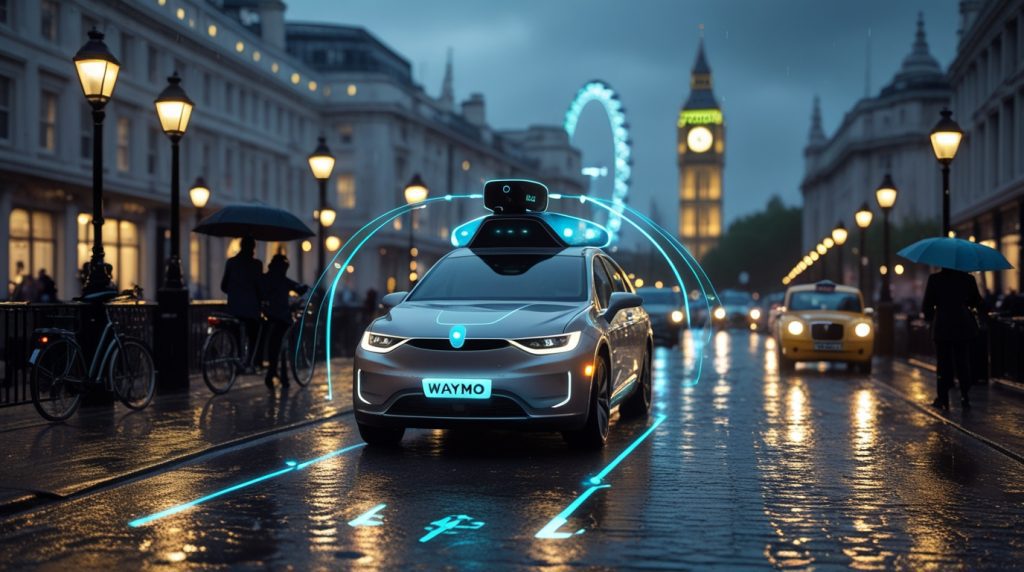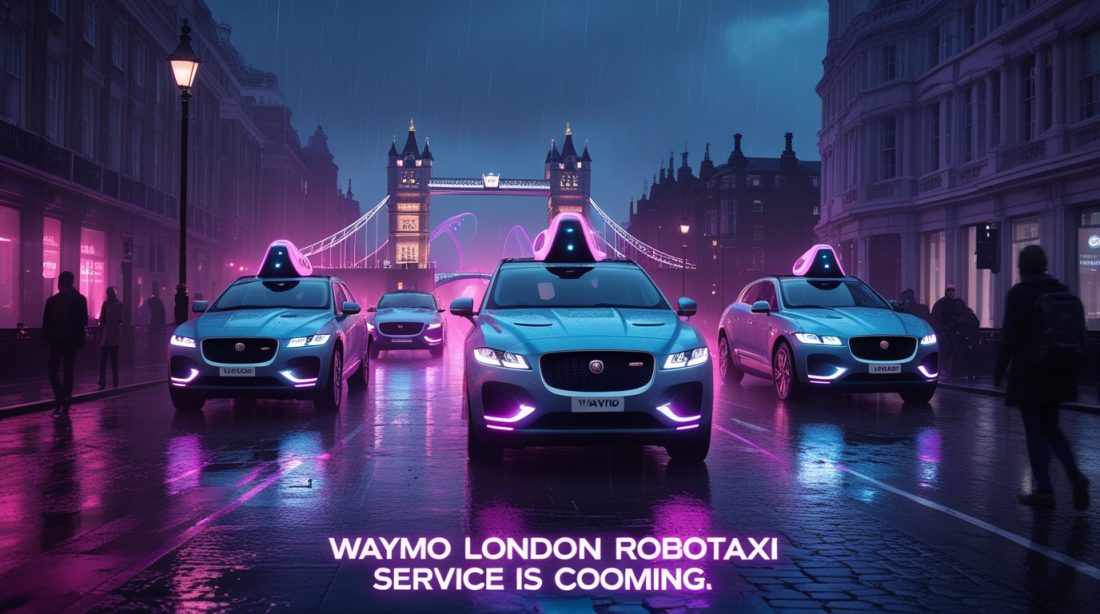TL;DR
Waymo, Alphabet’s self-driving unit, officially announced its Waymo London robotaxi service for 2026. This self-driving car service in London will be the company’s first in Europe and second global expansion after Waymo testing in Tokyo.
A fleet of all-electric Waymo Jaguar I-PACE London vehicles will be managed by Waymo’s Moove partnership in London. Strategically, this aligns with the UK Automated Vehicles Act and government support for commercial pilots of autonomous vehicles, expected to kick off by Spring 2026. The move pits Waymo against the UK-based startup Wayve, intensifying the Waymo vs Wayve London competition.
As part of a global surge in autonomous systems, Waymo’s London rollout reflects the same industrial AI momentum seen in China’s National Day robotics deployments and MIT’s generative AI training breakthroughs.
Why is Waymo’s London Launch a Strategic Move?
The Waymo London robotaxi service is part of Waymo’s global growth plan. After operating in five U.S. cities and expanding to Tokyo, entering London is a significant leap for its driverless taxi presence in the UK.
The Waymo London launch date 2026 aligns with new British regulations under the UK Automated Vehicles Act, enabling autonomous ride services to begin safely and legally.
“I’m delighted that Waymo intends to bring their services to London next year, under our proposed piloting scheme,” said Heidi Alexander, UK Secretary of State for Transport. “Boosting the AV sector will bring jobs and investment opportunities to the UK.”
Waymo also benefits from existing ties — its Waymo engineering hub in Oxford and long-term partnership with Jaguar Land Rover strengthen its electric autonomous taxi UK operation.
Why London Poses a Unique Challenge for Autonomous AI

From an industrial AI lens, London may be Waymo’s toughest test yet. Its centuries-old streets and unpredictable traffic create real-world complexities unseen in U.S. test cities.
Narrow lanes, cyclists, and ever-changing conditions like rain test both AI prediction and safety systems. Critics, including London’s taxi representatives, question whether Waymo driverless taxis in the UK can adapt to such an environment or handle “black cab competition” effectively.
Waymo’s spokesperson defended the system, stating: “The Waymo Driver uses lidar, cameras, radar, and an advanced onboard computer to understand the world around the vehicle.”
This Waymo lidar sensor technology ensures reliability, even in challenging weather. But questions like “Are Waymo cars safe in rain?” remain a point of public curiosity and debate.
This challenge mirrors issues seen in industrial environments where pre-trained vision models fail in dust-heavy conditions
and AI retraining budgets collapse mid-cycle.
Fictional Anecdote
Imagine a cyclist named Ben navigating a crowded London street. He signals to pass a delivery van — a common scenario. For a Waymo autonomous vehicle in London, the AI must instantly predict Ben’s motion and plan accordingly. This shows how Waymo’s robotaxi expansion in Europe pushes the limits of real-time AI decision-making.
Why Now? The Confluence of Tech and Regulation
The Waymo London robotaxi service combines technical maturity with perfect timing. With 100 million miles driven autonomously and over 10 million weekly rides completed in U.S. cities, Waymo’s experience gives it an edge. This echoes broader industrial AI trends like AI downtime prediction monetization and AI-powered control systems.
The UK’s proactive policies, backed by Transport for London, further clear the path. The London robotaxi regulations 2026 under the new act enable pilots to proceed faster.
Deployment Timeline:
- Late 2025: Safety driver testing phase
- 2026: Book a Waymo taxi in London via the Waymo app download London for public pilot rides
- Post-2027: Full-scale rollout following full Automated Vehicles Act implementation
Industrial AI Analysis: Safety and Market Position
Waymo emphasizes its safety record in London trials, citing fewer injury-causing collisions compared to human drivers. Such data strengthens its case amid rising public opinion on Waymo in London and helps reassure regulators.
Waymo’s experience contrasts with Wayve’s more localized approach. The table below outlines their key differences:
| Company | Core Technology | Key Partner | Strategic Advantage |
|---|---|---|---|
| Waymo | Lidar, Cameras, Radar | Moove | Global experience, Waymo miles driven autonomous |
| Wayve | Camera-Based AI | Uber | Homegrown startup, Uber partnership |
Additionally, Waymo’s prior collaborations, like the Uber-Waymo partnership in Atlanta, show its flexibility in sharing expertise and infrastructure globally.
Challenges Ahead and Market Perception
As the future of transport in London unfolds, the success of Waymo will hinge on balancing safety, affordability, and trust. Questions like the cost of a Waymo ride in London and competition with traditional black cabs will shape consumer behavior.
Moreover, Waymo London job opportunities are expected to grow, attracting AI engineers, fleet operators, and data specialists to the UK.
Final Thoughts
The Waymo London robotaxi service represents a landmark in autonomous ride-hailing in London and across Europe. With its Oxford engineering roots, Moove partnership, and advanced AI, Waymo is betting on a future where autonomous mobility becomes as routine as hailing a cab.
Still, challenges remain — from London robotaxi regulations 2026 to fierce Waymo vs Wayve London competition. Whether this industrial AI experiment succeeds or stalls will depend on how well it earns public trust and navigates London’s ever-evolving roads.
FAQ
When will Waymo robotaxis be available in London?
Waymo plans to roll out its driverless taxi UK service in 2026, depending on regulatory approval.
What cars will Waymo use?
A fleet of all-electric Jaguar I-PACE vehicles will power the Waymo London robotaxi service, managed through its Moove partnership.
Will the cars have safety drivers?
Yes, during the testing phase. Fully autonomous rides will begin in 2026.
How does Waymo work in cities?
The Waymo Driver combines lidar, radar, and AI-powered prediction to perceive the world and drive safely.
How can I book a Waymo ride?
Riders will be able to book a Waymo taxi in London through the Waymo app once the pilot launches.
Are there competitors?
Yes. The Waymo vs Wayve London rivalry represents the next big chapter in electric autonomous taxi UK innovation.
Stay Updated:
Subscribe to our newsletter for updates on Waymo’s robotaxi expansion in Europe, autonomous vehicle laws, and future transport innovations in London.



